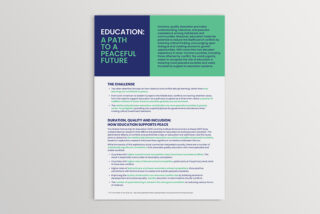WASHINGTON D.C./LONDON, JANUARY 24, 2024: The Global Partnership for Education (GPE), and the Institute for Economics & Peace (IEP), have released new research providing compelling evidence of the strong relationship between education and peace. Released on the International Day of Education, the analysis demonstrates how improvements in education levels are closely linked to more peaceful societies.
The past decade has been marked by lethal conflicts, crises and wars. Across the globe, wars keep taking countless lives, displacing civilians from their homes and leaving many more in a dire need of life-saving assistance. There is an urgent need to rebuild the foundations that can underpin lasting peace, and yet too often one of the most crucial of these, education, is often relegated to a development afterthought.
“This year began with a dismal global outlook for peace, but we can restore hope by urgently investing more in education”, said Laura Frigenti, GPE Chief Executive Officer. “It is time we heeded the mounting evidence that education is a smart, mutually sustaining investment in prosperity and peace.”
While the disastrous impacts of conflict on education are widely acknowledged, research on the reciprocal relationship between peace and education has been sparse and outdated. To fill this essential knowledge gap and provide evidence to drive sound policies, the GPE has partnered with the IEP to break down and better understand the relationship between education and peace.
Key finding:
Mounting evidence has shown that investing in education is essential for peacebuilding. There is an urgent need to ensure adequate resources are channelled to education. This can allow governments, donors and international organizations to live up to their collective responsibility of giving every girl and boy the opportunity to get the knowledge and skills they need to usher in more peaceful and prosperous future.
For more information, visit globalpartnership.org and visionofhumanity.org.
